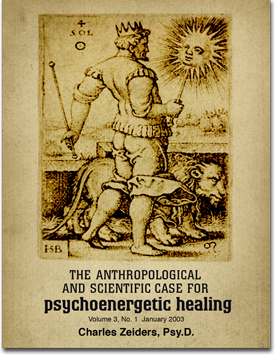The Anthropological & Scientific Case for Psychoenergetic Healing

Abstract
Part 1. This dissertation examines psychoenergetic (bioenergy) psychotherapy, the anthropological and scientific/medical validity of bioenergy as a construct, and three psychoenergetictherapy paradigms with mature theories and interventions. Paradigms discussedinclude pre-psychodynamic (Christian), psychodynamic (Pierrakos, Lowen, Brennan), and post-psychodynamicpsychoenergetic (Confluent Somatic Therapy of Steven Vazquez) psychotherapy.
Part 2. In the next issue of IJHC, a phenomenological study explores psychoenergeticexperiences common across three highly advanced psychoenergetic psychotherapists who arerepresentative of each of the above groups. The study isolates common psychoenergeticexperiences, qualifies and describes/interprets them, and recommends a technical vocabularyto formalize them.
Overview
This dissertation addresses psychoenergetic psychotherapy. A review of the principle psychoenergetictherapy paradigms along with a phenomenological analysis of psychoenergetictherapists’ energetic experiences, investigates this under-researched form of therapy. Thesetherapies involve the conscious use of bioenergy on the part of the therapist to allaypsychological and/or somatic suffering experienced by the client. This bioenergy is describedas a subtle substance with healing effects. Anthropological and scientific evidence support theexistence of energy and upholds its validity as a construct.
We will start with a review of evidence that bioenergy comprises an essential portion of thehuman experience as witnessed by historical and cross-cultural agreement that a subtle healingsubstance (or substances) exist either in nature or the supernatural. Moreover, scientific andmedical domains have generated an impressive literature base regarding the utilization ofbioenergy. A review shows that the clinical effects of subtle energies are measurable, thathuman beings both generate and psychosomatically respond to electromagnetism (a likelycomponent of bioenergy), and that modem medical pioneers utilized energy in treatments.We will survey theoretical and technical aspects of the main psychoenergetic psychotherapyschools, including:
1. Pre-psychodynamic or Christian psychoenergetic psychotherapy: Theory and practice fromthe first century in Palestine through the twentieth century in the pastoral counseling office.Theology and mystical experience provide the theoretical underpinnings of this school, whilecase studies and carefully scrutinized anecdotal evidence illustrate the technical aspects andconfirm its effectiveness.
2. The development of psychodynamic psychoenergetic principles and practices. Psychodynamic energy theory develops from the concepts of neurosis in classical psychoanalysis and reaches a controversial maturity in Orgonomy and its offshoots.Psychodynamic psychoenergetic practices develop from mainstream Freudian analysis andcharacter analytic vegetotherapy, including Bioenergetic treatment (Lowen), Core energetictreatment (Pierrakos), energy practices involving spirits (Brennan).
3. Post-psychodynamic psychoenergetic therapy or Confluent Somatic Therapy (CST) of Steven Vazquez: Conceptual and practical components.Because parallels exist between psychologically oriented CST and its more investigated nursingcounterpart, Therapeutic Touch (TT), research regarding the mechanisms and efficacy of TT isreviewed and related to CST.
The final section will present new research into psychoenergetic psychotherapy (in a later issueof IJHC). A phenomenological investigative study explores the experiences of three psychoenergetictherapists who practice or draw upon one of the above therapeutic energy schools.The nature of psychoenergetic experiences common across therapists is developed from thedata and a proposed technical vocabulary defines these experiences and suggests further study.
Click Here To Download And Read This Article In Its Entirety